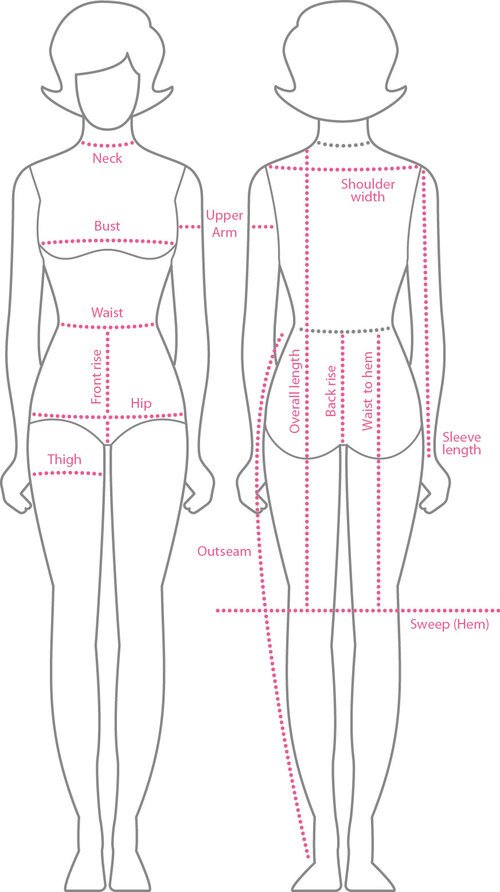This is an excerpt from my book Wear Vintage Now! Choose It, Care for It, Style It Your Way
Of the handful of Really Important Issues when choosing vintage clothing, fit is probably number one for most people. There’s quite a lot to cover, so let’s get started.
THE IMPORTANCE OF MEASUREMENTS
There is no standard by which vintage sellers collectively describe sizes, but let’s be fair, there is no precise standard for modern clothing either! Sometimes you’ll see a vintage item that has its original tag or label with the size marked on it, but don’t confuse this with current sizing. Vintage sizes do not coincide with modern sizes, nor are they predictable when compared with other items from the same era. In her study of advertisements in Vogue magazine from 1922 to 1999, Alaina Zulli found a great deal of irregularity, with a generally decreasing size number through the decades, due to so-called vanity sizing. As summarized in 2011, Ms. Zulli found that in the Sears catalogue of 1937 for instance, a woman with a 32′′ bust would have worn a size 14. She would have worn a size 8 by 1967, and today, she’s wearing a size 0.* Fit is all about measurements, not stated sizes.
I have tried to at least codify my own modern size estimates for the vintage items I have for sale, based on an assortment of websites’ and catalogues’ size charts. Other vintage sellers have done something similar. However, I would recommend that if you see U.S. size 6, say, or XL, even in my listings, do not assume it is the same as your idea of size 6 or XL. Go straight for the measurements and compare those to your own.
Many sellers, including me, suggest that you compare the measurements of an item you’re interested in with something similar of your own that fits you well. This is great if indeed you have a piece that is similar to the vintage item in key ways, for instance both are made of woven, non-stretchy fabric and are fitted in the same ways. I will later make suggestions about how to choose items even if you have nothing similar.
When should you ask for further help from an online vintage seller? By all means ask if there are no/not enough measurements or the condition is not described. A seller who offers almost no information may be a beginner or simply not very skillful. One characteristic that good sellers share is that their listings include most or all of the information you need to make an informed decision. Most good sellers will be happy to guide you if you need further help with the size or some other aspect. Just remember, don’t ask if that 1950s dress is a size 6—ask about the item’s measurements.
So now that you understand the importance of measurements for fit, here are the most common measurements you will need for clothing:
It is an extremely good idea to have someone help you with these measurements, at least the ones that would require advanced contortionism to manage on your own. Use a cloth measuring tape and keep it straight and snug but not tight as you measure. Stand tall and relaxed and don’t suck in, especially for the bust and waist measures.
Bust: With your bra on, measure around your body at the fullest part of your bust.
Under-bust measure: Measure around your body just under your bust.
Waist: Measure around the smallest part of your waist, just above your belly button.
Hips: With heels together, measure around the fullest part of your hips, about 8′′ (20.3 cm) down from your waist.
Shoulder width: Imagine lines going straight up from your armpits to your shoulders in back. Measure from this point on one shoulder to the other, across the back.
Outer sleeve length: Measure from the tip of your shoulder to your wrist along the outside of your arm.
Upper arm: Measure around the fullest part of your upper arm.
Neck: Wrap the tape around your neck about 1′′ (2.5 cm) above the point where your shoulder meets your neck.
Back waist length: Measure from the base of your neck to your waist in back.
Inseam: While standing straight, measure from the groin to the place where you would like the hem of the pants to fall (ankle or floor).
Outer leg length: Measure from the waist to the point where the hem of the pants will fall.
Rise (front and back): Measure from the groin to your waist at center front for the front rise, and at center back for the back rise.
Allow me to digress a moment here. You can be any size and look great; you just have to be honest about the size you really are. For instance, when you measure your waist, don’t suck in or you’ll have to live with permanent duck face while wearing too-tight clothes. If you lose that weight you’ve been meaning to lose or whittle your waist with exercise, you can find a new vintage frock or alter what you have. But now is now—and you deserve to look and feel great right now! There are vintage foundation garments that will help you modify your size somewhat, but for starters, let’s stick with the basics.
Now, what vintage garment are you going to look for first? My suggestion is a sweater because 1) a sweater’s fit is flexible—you are practically guaranteed success—and 2) vintage sweaters are the best!
*Clifford, Stephanie. “One Size Fits Nobody: Seeking a Steady 4 or a 10.” New York Times, April 24, 2011.
Look for tips on finding a vintage sweater, in my blog soon!

